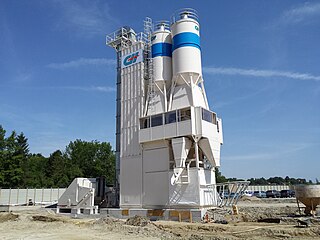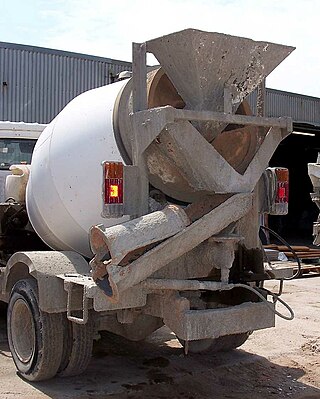
Concrete is a composite material composed of aggregate bonded together with a fluid cement that cures to a solid over time. Concrete is the second-most-used substance in the world after water, and is the most widely used building material. Its usage worldwide, ton for ton, is twice that of steel, wood, plastics, and aluminium combined.

A cement is a binder, a chemical substance used for construction that sets, hardens, and adheres to other materials to bind them together. Cement is seldom used on its own, but rather to bind sand and gravel (aggregate) together. Cement mixed with fine aggregate produces mortar for masonry, or with sand and gravel, produces concrete. Concrete is the most widely used material in existence and is behind only water as the planet's most-consumed resource.

Portland cement is the most common type of cement in general use around the world as a basic ingredient of concrete, mortar, stucco, and non-specialty grout. It was developed from other types of hydraulic lime in England in the early 19th century by Joseph Aspdin, and is usually made from limestone. It is a fine powder, produced by heating limestone and clay minerals in a kiln to form clinker, and then grinding the clinker with the addition of several percent gypsum. Several types of portland cement are available. The most common, historically called ordinary portland cement (OPC), is grey, but white portland cement is also available. Its name is derived from its resemblance to Portland stone which is quarried on the Isle of Portland in Dorset, England. It was named by Joseph Aspdin who obtained a patent for it in 1824. His son William Aspdin is regarded as the inventor of "modern" portland cement due to his developments in the 1840s.

A road surface or pavement is the durable surface material laid down on an area intended to sustain vehicular or foot traffic, such as a road or walkway. In the past, gravel road surfaces, macadam, hoggin, cobblestone and granite setts were extensively used, but these have mostly been replaced by asphalt or concrete laid on a compacted base course. Asphalt mixtures have been used in pavement construction since the beginning of the 20th century and are of two types: metalled (hard-surfaced) and unmetalled roads. Metalled roadways are made to sustain vehicular load and so are usually made on frequently used roads. Unmetalled roads, also known as gravel roads or dirt roads, are rough and can sustain less weight. Road surfaces are frequently marked to guide traffic.

Mortar is a workable paste which hardens to bind building blocks such as stones, bricks, and concrete masonry units, to fill and seal the irregular gaps between them, spread the weight of them evenly, and sometimes to add decorative colours or patterns to masonry walls. In its broadest sense, mortar includes pitch, asphalt, and soft clay, as those used between bricks, as well as cement mortar. The word "mortar" comes from the Old French word mortier, "builder's mortar, plaster; bowl for mixing." (13c.).

Asphalt concrete is a composite material commonly used to surface roads, parking lots, airports, and the core of embankment dams. Asphalt mixtures have been used in pavement construction since the beginning of the twentieth century. It consists of mineral aggregate bound together with bitumen, laid in layers, and compacted.

A concrete mixer is a device that homogeneously combines cement, aggregate, and water to form concrete. A typical concrete mixer uses a revolving drum to mix the components. For smaller volume works, portable concrete mixers are often used so that the concrete can be made at the construction site, giving the workers ample time to use the concrete before it hardens. An alternative to a machine is mixing concrete by hand. This is usually done in a wheelbarrow; however, several companies have recently begun to sell modified tarps for this purpose.

Ready-mix concrete (RMC) is concrete that is manufactured in a batch plant, according to each specific job requirement, then delivered to the job site "ready to use".
Full depth recycling or full depth reclamation (FDR) is a process that rebuilds worn out asphalt pavements by recycling the existing roadway.

Concrete recycling is the use of rubble from demolished concrete structures. Recycling is cheaper and more ecological than trucking rubble to a landfill. Crushed rubble can be used for road gravel, revetments, retaining walls, landscaping gravel, or raw material for new concrete. Large pieces can be used as bricks or slabs, or incorporated with new concrete into structures, a material called urbanite.

Lime mortar or torching is a masonry mortar composed of lime and an aggregate such as sand, mixed with water. It is one of the oldest known types of mortar, used in ancient Rome and Greece, when it largely replaced the clay and gypsum mortars common to ancient Egyptian construction.
Metakaolin is the anhydrous calcined form of the clay mineral kaolinite. Rocks that are rich in kaolinite are known as china clay or kaolin, traditionally used in the manufacture of porcelain. The particle size of metakaolin is smaller than cement particles, but not as fine as silica fume.

Feed mixers are used in feed mills for the mixing of feed ingredients and premixes. The mixer plays a vital role in the feed production process, with efficient mixing being the key to good feed production. If feed is not mixed properly, ingredients and nutrients will not be properly distributed when it comes time to extrude and pelletize the feed, or if the feed is to be used as mash. This means that not only would the feed not have nutritional benefit, it would be bad for the animals that are eating it.

Roller-compacted concrete (RCC) or rolled concrete (rollcrete) is a special blend of concrete that has essentially the same ingredients as conventional concrete but in different ratios, and increasingly with partial substitution of fly ash for portland cement. The partial substitution of fly ash for Portland Cement is an important aspect of RCC dam construction because the heat generated by fly ash hydration is significantly less than the heat generated by portland cement hydration. This in turn reduces the thermal loads on the concrete and reduces the potential for thermal cracking to occur. RCC is a mix of cement/fly ash, water, sand, aggregate and common additives, but contains much less water. The produced mix is drier and essentially has no slump. RCC is placed in a manner similar to road paving; the material is delivered by dump trucks or conveyors, spread by small bulldozers or specially modified asphalt pavers, and then compacted by vibratory rollers.
Remediation of contaminated sites with cement, also called solidification/stabilization with cement is a common method for the safe environmental remediation of contaminated land with cement. The cement solidifies the contaminated soil and prevents pollutants from moving, such as rain causing leaching of pollutants into the groundwater or being carried into streams by rain or snowmelt. Developed in the 1950s, the technology is widely used today to treat industrial hazardous waste and contaminated material at brownfield sites i.e. abandoned or underutilized properties that are not being redeveloped because of fears that they may be contaminated with hazardous waste. S/S provides an economically viable means of treating contaminated sites. This technology treats and contains contaminated soil on site thereby reducing the need for landfills.

Coal combustion products (CCPs), also called coal combustion wastes (CCWs) or coal combustion residuals (CCRs), are categorized in four groups, each based on physical and chemical forms derived from coal combustion methods and emission controls:

A concrete plant, also known as a batch plant or batching plant or a concrete batching plant, is equipment that combines various ingredients to form concrete. Some of these inputs include water, air, admixtures, sand, aggregate, fly ash, silica fume, slag, and cement. A concrete plant can have a variety of parts and accessories, including: mixers, cement batchers, aggregate batchers, conveyors, radial stackers, aggregate bins, cement bins, heaters, chillers, cement silos, batch plant controls, and dust collectors.

Concrete is produced in a variety of compositions, finishes and performance characteristics to meet a wide range of needs.
Soil stabilizers and road recyclers are engineering vehicles that were once similar machines; however, they are now specialised pieces of road making machinery and have developed into different machines. Other terms that are sometimes used are: road profiler, road reclaimer, road miller, road planer and pavement profiler. They are used in the process of full depth recycling.
Changuinola I Dam, is located in district of Changuinola, in the Province of Bocas del Toro, in the western part of Panama. It is the largest roller-compacted concrete arch-gravity dam in the World.















